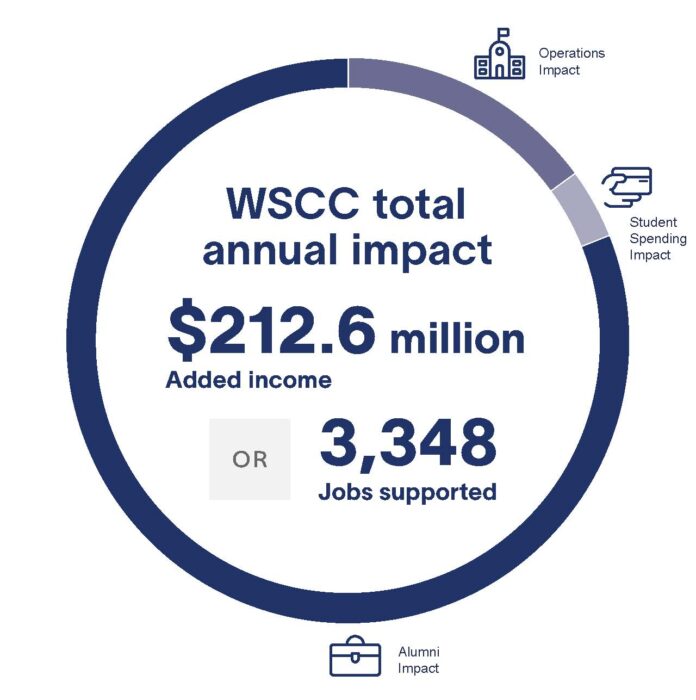HANCEVILLE, Ala. — A new economic report shows the impact one college can have on a region, and a system on a state. Wallace State Community College annually adds approximately $212.6 million to the local economy and supports 3,348 jobs in the college’s four-county service area, providing an economic boost to the region on par with hosting the World Series 27 times, and larger than the area’s entire utilities industry.
These facts are part of an analysis that finds students and alumni of colleges within the Alabama Community College System add $6.6 billion to Alabama’s economy, supporting one out of every 27 jobs in the state, according to an economic impact report released Monday.
The independent, 102-page report by Lightcast estimates the Alabama Community College System directly impacts 98,923 jobs in the state, representing about 2.7% of Alabama’s gross state product. Additionally, taxpayers see a net benefit of $1.1 billion in added tax revenue from students’ higher lifetime earnings and increased output to businesses.
“Daily, I see the impact Wallace State Community College has on the lives of our students and the communities we serve,” said WSCC President Dr. Vicki Karolewics. “This study only verifies what I’ve known for years because I experienced it myself – that a community college education pays for itself over and over again, not only for each student who chooses to open the door to opportunity through education, but for their communities as well. We are a good investment.”
Wallace State’s impact has only grown over time. A previous economic impact report done several years ago showed Wallace State’s return on investment was 10 to 1, with $10 returned to the economy for every $1 invested. Today, Wallace State returns more than $11.50 to society for every $1 invested.
The education and training Wallace State provide have the greatest impact on its service area, more than the dollars the college spends on goods and services. Since the establishment of the college, students have studied at Wallace State and entered the regional workforce with greater knowledge and new skills. As a result of their education, they receive higher earnings and increase the productivity of the businesses that employ them.
On average, students who attend Wallace State see an impressive 21.2% annual rate of return on the investment they make in their education. For context, the study sites the U.S. stock market’s 30-year average rate of return at 10.5%. Over a working lifetime, the benefits of an associate degree over a high school diploma will amount to a value of $373,800 in higher earnings per graduate.
Taxpayers, too, benefit from added tax revenue, stemming from students’ higher lifetime earnings and increased business output, amounting to $75.7 million.
The societal benefits of Wallace State are much greater, with a present value of $893.1 million, the study finds. These benefits include $621.4 million in added student income, $221.6 million in added business income, $31.0 million in added income from college activities, as well as $19.1 million in social savings related to health, crime and income assistance in Alabama.
“Our legacy centers on helping people develop the skills they need to help build the framework of our state’s economy, and the data this report provides proves we are on a forward path of excellence in that pursuit,” said Jimmy H. Baker, chancellor of the Alabama Community College System. “Residents are receiving a strong return on investment when they invest in training at one of our colleges – whether through an adult education program, rapid skills training program, rigorous certification or academic transfer program that allows them to move toward completing a bachelor’s degree. And they’re using that training to make a difference right here in Alabama.”
A total of 95% of Alabama community college students remain in the state to live and work.
The report is careful to point out that ROI from one institution cannot be easily compared to another institution nor across regions because results consider factors such as the cost of living, economic vitality, opportunities and unemployment rates in a given area.
Lightcast, a global leader in labor market analytics for colleges and universities, analyzed data using FY2020-21 academic and financial reports from Alabama’s community and technical colleges, as well as industry and employment data from the Bureau of Labor Statistics and Census Bureau.
The full state report can be found at www.accs.edu/impact.


















